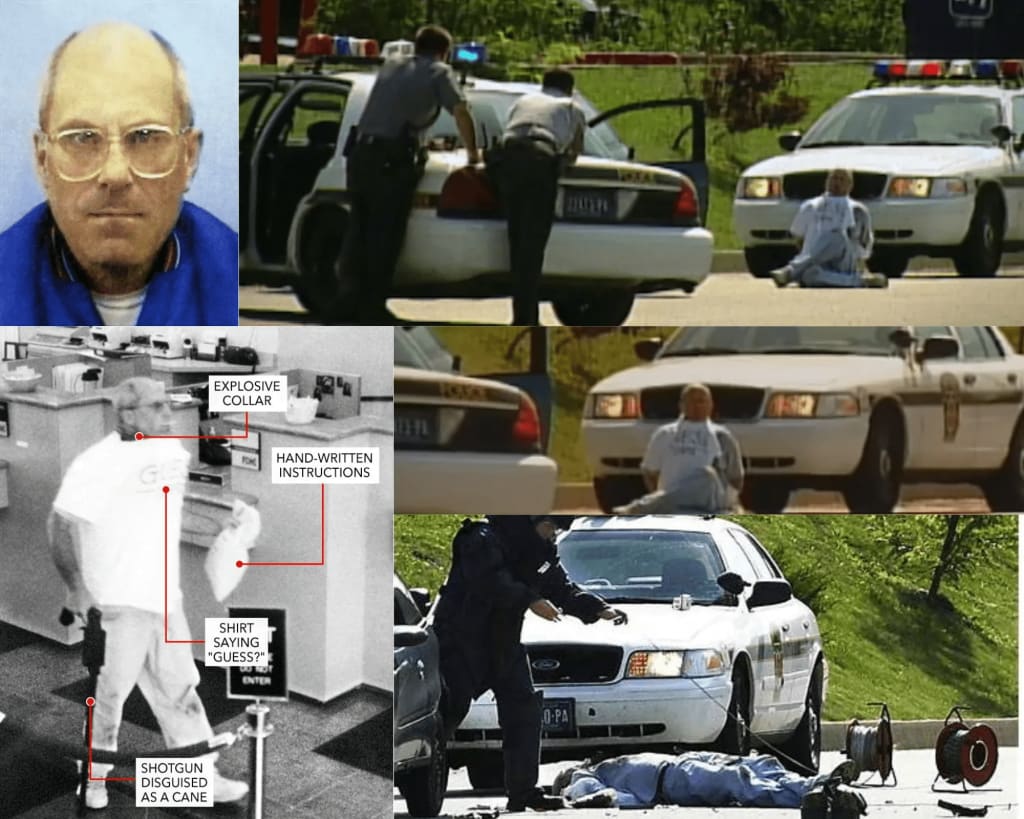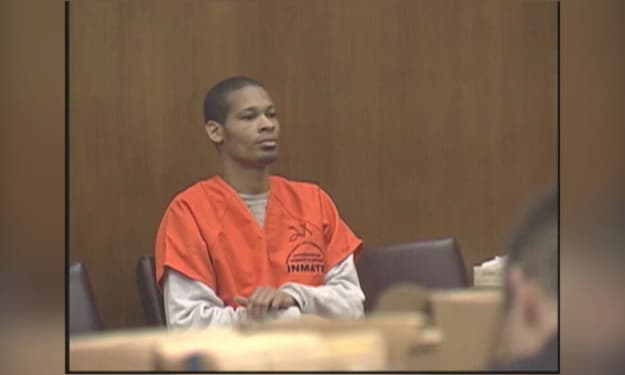The Infamous Pizza Bomber: How a Bank Heist and a Collar Bomb Shocked America
The Bizarre Case of Brian Wells and the Erie, Pennsylvania Heist

On August 28, 2003, the quiet city of Erie, Pennsylvania, became the epicenter of one of the most bizarre and tragic criminal cases in U.S. history. Dubbed the "Pizza Bomber" case, it involved a bank heist, a homemade explosive collar, and a series of events that seemed straight out of a Hollywood thriller. This article delves into the intricate details of the crime, the investigation, and the twisted individuals behind it.
The Bank Heist
The incident began when police received a 9-1-1 call about an active bank robbery in progress. Brian Wells, a short, bald, middle-aged man, entered the PNC Bank with a walking stick, which later turned out to be a disguised shotgun. Around his neck was a bulky metal collar concealed by a t-shirt. He handed the bank teller a note demanding $250,000 and revealed the bomb strapped to his neck. Despite his threatening appearance, Wells remained eerily calm, even sucking on a lollipop from the bank's counter.
The bank staff, trained to comply in such situations, scrambled to gather the money. However, the complex security protocols made it impossible to retrieve such a large sum quickly. Wells eventually settled for $8,702 and left the bank without harming anyone.
The Arrest and the Bomb
Wells was intercepted by police shortly after leaving the bank. They apprehended him in the parking lot of an Eyeglass World store. Still wearing the collar bomb, Wells was handcuffed and seated on the ground while officers kept a safe distance, fearing the bomb could detonate at any moment.
As they awaited the bomb squad, officers questioned Wells from afar. He revealed that he was a pizza delivery driver who had been abducted while making a delivery. According to Wells, his abductors strapped the bomb to his neck and forced him to rob the bank, threatening to detonate the device if he didn't comply. Wells described his abductors as three black men but could provide no other details.
At 3:18 p.m., the collar bomb began to beep. Witnesses described Wells's look of sheer panic as he desperately tried to remove the device. Within seconds, the bomb exploded, creating a five-inch hole in Wells's chest and killing him instantly. Tragically, the bomb squad arrived just minutes too late to save him.
The Investigation
Brian Wells's death left investigators with numerous questions. Who were his abductors, and why was he targeted? The first step was to examine Wells's background. At 46, Wells led a quiet, unassuming life. He worked at Mama Mia's Pizzeria, lived alone with his three cats, and was known for his quirky aversion to technology. He had no known enemies or criminal history, making his involvement in such a dramatic crime all the more perplexing.
The investigation took a significant turn when police searched Wells's car. Inside, they found a series of handwritten letters addressed to "bomb hostage." These letters outlined a macabre scavenger hunt, with detailed instructions on how Wells could collect keys and codes to unlock the bomb. The notes were filled with dire warnings about what would happen if he deviated from the plan or contacted authorities.
Details from the Letters
The letters discovered in Wells's car painted a terrifying picture of his ordeal. Addressed to "bomb hostage," the letters were meticulously detailed and designed to instill fear and compliance. Here are some key excerpts from the letters:
- Instructions to Rob the Bank: "Proceed to the PNC Bank and give the teller the note provided. Show them the bomb and demand $250,000. You have 15 minutes to complete this task."
- Threats and Warnings: "If you see any police following you or helicopters overhead, we will detonate the bomb. Do not try to remove the collar, it is booby-trapped and will explode."
- Scavenger Hunt Directions: "After retrieving the money, proceed to the McDonald's on Peach Street. Look for a rock in the flower bed with your next clue taped to it."
- False Promises: "Follow all instructions exactly to find the keys and codes that will unlock the bomb. Failure to comply will result in your immediate death."
These letters created a chilling roadmap of fear and manipulation, ensuring Wells felt he had no choice but to follow the instructions to the letter.
The Unraveling Conspiracy
Despite the disturbing content of the letters, the investigation initially hit a dead end. That changed three weeks later when a man named Bill Rothstein called police to report a body in a freezer at his home on Peach Street—the same street where Wells was abducted. Rothstein claimed his friend, Marjorie Diehl-Armstrong, had killed her boyfriend and asked him to help dispose of the body.
Police arrested Rothstein and Diehl-Armstrong. Rothstein, a former lover of Diehl-Armstrong, admitted to helping her but denied any involvement in the murder. However, his connection to the pizza bombing became evident when police found a notebook with his handwriting matching the letters found in Wells's car. Rothstein's home also contained tools and machinery that could have been used to construct the collar bomb.
The FBI's Complex Investigation
The FBI described the investigation into Brian Wells's death as "one of the most complicated and bizarre crimes in the annals of the FBI." The complexity arose from the sheer intricacy of the plot and the multiple players involved, each with their own convoluted motivations and connections.
Multiple Suspects and Confessions
During the investigation, multiple individuals were implicated. Diehl-Armstrong was a manipulative and mentally ill woman with a history of relationships ending in mysterious deaths. Diagnosed with multiple mental health disorders, including bipolar disorder and narcissistic personality disorder, she had been in and out of therapy for years. Despite her volatile nature, she was popular and attractive, using her looks and charm to manipulate men.
During police interrogation, Diehl-Armstrong initially denied involvement in the pizza bombing. However, after Rothstein's death from cancer, she began to talk, claiming that Rothstein had indeed helped her but shifting most of the blame onto him. She also implicated a man named Kenneth Barnes, a crack dealer and friend of hers, in the plot.
Uncovering the Plot
Through the testimony of fellow inmates and additional investigation, police pieced together the truth. Diehl-Armstrong and Rothstein devised the plan to use a collar bomb to force someone to rob a bank. They roped in Kenneth Barnes, who knew a local prostitute, Jessica Hoopsick. Hoopsick, who had a close relationship with Wells, suggested him as a target, believing he would be easily intimidated.
Diehl-Armstrong and Rothstein planned to use the money from the robbery to pay Barnes to kill Diehl-Armstrong's father for his inheritance. On the day of the robbery, Wells was lured by a fake pizza delivery call, abducted, and fitted with the collar bomb. Despite being told it was a fake bomb, Wells only realized the truth moments before it detonated.
The True Story Emerges
As the FBI continued to unravel the intricate web of lies and deceit, they discovered more about the sinister motives behind the crime. The detailed planning, the manipulation of various individuals, and the cold-blooded nature of the crime revealed a level of complexity rarely seen in criminal cases.
Motive and Execution
Diehl-Armstrong's desperation for money was the driving force behind the plot. She planned to use the proceeds from the bank robbery to pay Kenneth Barnes to kill her father, ensuring her inheritance. The involvement of Rothstein, who harbored a long-time infatuation with Diehl-Armstrong, added another layer to the conspiracy. He provided the technical expertise to construct the collar bomb, further complicating the investigation.
The Role of Kenneth Barnes and Jessica Hoopsick
Barnes, a crack dealer known as "Cocaine Kenny," was pivotal in executing the plan. His connection to Jessica Hoopsick, who introduced Wells as the target, highlighted the extent of manipulation involved. Hoopsick later claimed she believed the plan was a joke, not realizing the deadly seriousness until it was too late.
The Aftermath
Marjorie Diehl-Armstrong was convicted of armed bank robbery, conspiracy to commit armed bank robbery, and using a destructive device in a violent crime. She was sentenced to life in prison plus 30 years but died of breast cancer in 2017. Kenneth Barnes pleaded guilty and received a 25-year sentence but passed away in 2019. Rothstein, already deceased, was posthumously identified as a key conspirator.
The pizza bombing case remains one of the most convoluted and tragic criminal cases in American history. The chilling nature of the crime, combined with the bizarre and manipulative actions of those involved, continues to captivate and horrify those who learn about it.
About the Creator
Sally A
Animal lover 🐾 | Health enthusiast 💪 | Self-development junkie 🌱 | Beauty explorer 💄 | True crimes & mystery enthusiast 🕵️♀️ | Let's journey together! 💫
Enjoyed the story? Support the Creator.
Subscribe for free to receive all their stories in your feed. You could also become a paid subscriber, letting them know you appreciate their work.






Comments (1)
Thank you for your interesting and exciting stories. Follow my stories now.